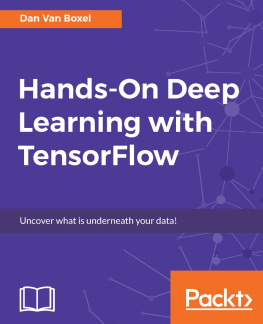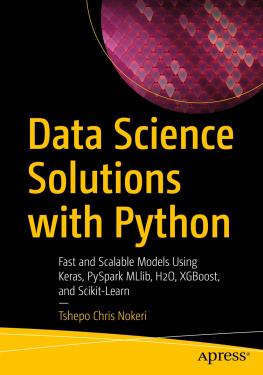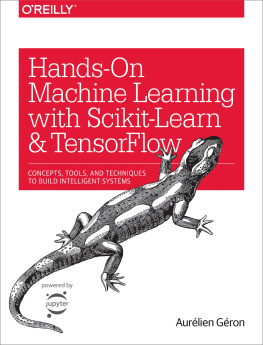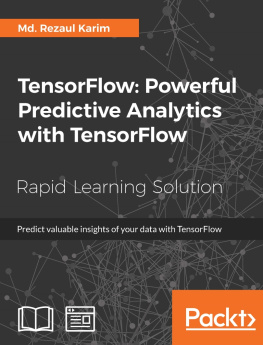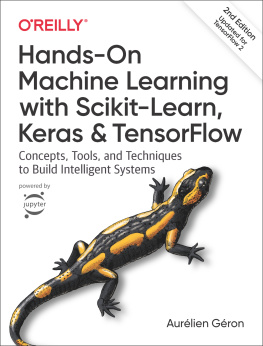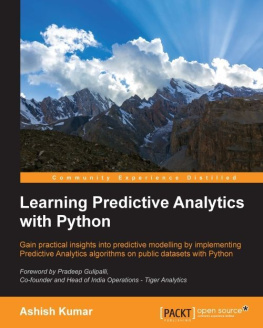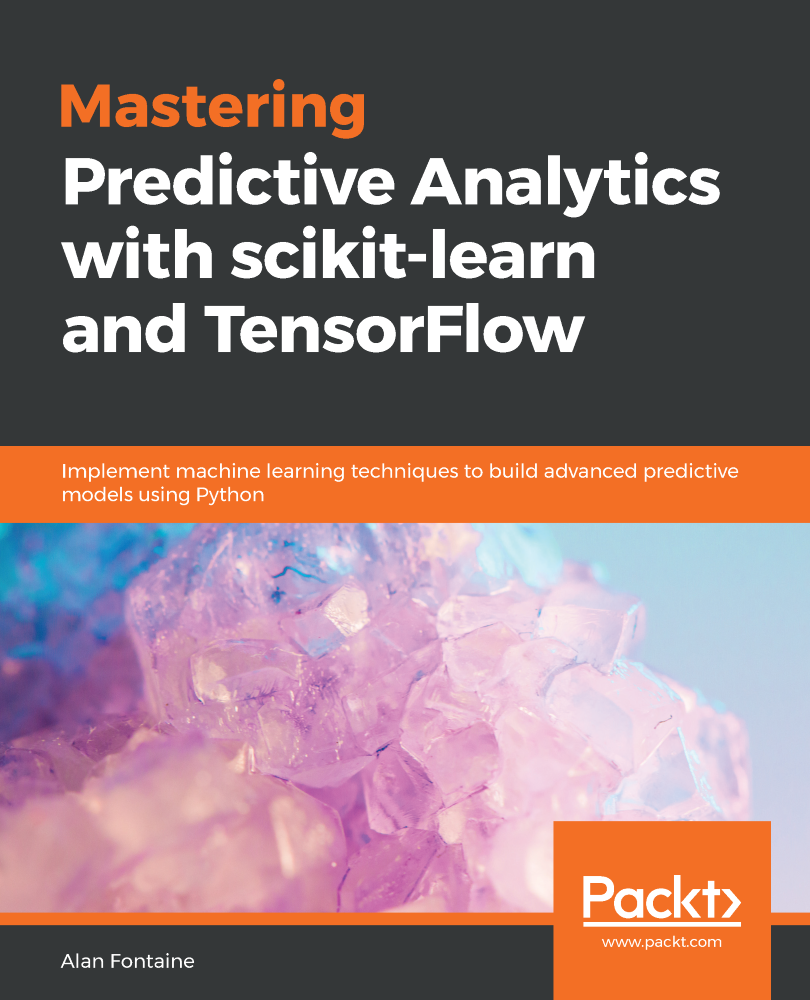
Mastering Predictive Analytics with scikit-learn and TensorFlow
Implement machine learning techniques to build advanced predictive models using Python
Alan Fontaine

BIRMINGHAM - MUMBAI
Mastering Predictive Analytics withscikit-learn and TensorFlow
Copyright 2018 Packt Publishing
All rights reserved. No part of this book may be reproduced, stored in a retrieval system, or transmitted in any form or by any means, without the prior written permission of the publisher, except in the case of brief quotations embedded in critical articles or reviews.
Every effort has been made in the preparation of this book to ensure the accuracy of the information presented. However, the information contained in this book is sold without warranty, either express or implied. Neither the author, nor Packt Publishing or its dealers and distributors, will be held liable for any damages caused or alleged to have been caused directly or indirectly by this book.
Packt Publishing has endeavored to provide trademark information about all of the companies and products mentioned in this book by the appropriate use of capitals. However, Packt Publishing cannot guarantee the accuracy of this information.
Commissioning Editor: Sunith Shetty
Acquisition Editor: Namrata Patil
Content Development Editor: Athikho Sapuni Rishana
Technical Editor: Joseph Sunil
Copy Editor: Safis Editing
Project Coordinator: Kirti Pisat
Proofreader: Safis Editing
Indexer: Rekha Nair
Graphics: Jisha Chirayil
Production Coordinator: Deepika Naik
First published: September 2018
Production reference: 1280918
Published by Packt Publishing Ltd.
Livery Place
35 Livery Street
Birmingham
B3 2PB, UK.
ISBN 978-1-78961-774-0
www.packtpub.com
mapt.io
Mapt is an online digital library that gives you full access to over 5,000 books and videos, as well as industry leading tools to help you plan your personal development and advance your career. For more information, please visit our website.
Why subscribe?
Spend less time learning and more time coding with practical eBooks and Videos from over 4,000 industry professionals
Improve your learning with Skill Plans built especially for you
Get a free eBook or video every month
Mapt is fully searchable
Copy and paste, print, and bookmark content
Packt.com
Did you know that Packt offers eBook versions of every book published, with PDF and ePub files available? You can upgrade to the eBook version at www.packt.com and as a print book customer, you are entitled to a discount on the eBook copy. Get in touch with us at customercare@packtpub.com for more details.
At www.packt.com , you can also read a collection of free technical articles, sign up for a range of free newsletters, and receive exclusive discounts and offers on Packt books and eBooks.
Contributor
About the author
Alan Fontaine is a data scientist with more than 12 years of experience in analytical roles. He has been a consultant for many projects in fields such as: business, education, medicine, mass media, among others. He is a big Python fan and has been using it routinely for five years for analyzing data, building models, producing reports, making predictions, and building interactive applications that transform data into intelligence.
Packt is searching for authors like you
If you're interested in becoming an author for Packt, please visit authors.packtpub.com and apply today. We have worked with thousands of developers and tech professionals, just like you, to help them share their insight with the global tech community. You can make a general application, apply for a specific hot topic that we are recruiting an author for, or submit your own idea.
Preface
Python is a programming language that provides various features in the field of data science. In this book, we will be touching upon two Python libraries, scikit-learn and TensorFlow. We will learn about the various implementations of ensemble methods, how they are used with real-world datasets, and how they improve prediction accuracy in classification and regression problems.
This book starts with studying ensemble methods and their features. We will look at how scikit-learn provides the right tools to choose hyperparameters for models. From there, we will get down to the nitty-gritty of predictive analytics and explore its various features and characteristics. We will be introduced to artificial neural networks, TensorFlow, and the core concepts used to build neural networks.
In the final section, we will consider factors such as computational power, improved methods, and software enhancements for efficient predictive analytics. You will become well versed in using DNNs to solve common challenges.
Who this book is for
This book is for data analysts, software engineers, and machine learning developers who are interested in implementing advanced predictive analytics using Python. Business intelligence experts will also find this book indispensable as it will teach them how to go from basic predictive models to building advanced models and producing better predictions. Knowledge of Python and familiarity with predictive analytics concepts are assumed.
What this book covers
, Ensemble Methods for Regression and Classification , covers the application of ensemble methods or algorithms to produce accurate predictions of models. We will go through the application of ensemble methods for regression and classification problems.
, Cross-validation and Parameter Tuning , explores various techniques to combine and build better models. We will learn different methods of cross-validation, including holdout cross-validation and k-fold cross-validation. We will also discuss what hyperparameter tuning is.
, Working with Features , explores feature selection methods, dimensionality reduction, PCA, and feature engineering. We will also study methods to improve models with feature engineering.
, Introduction to Artificial Neural Networks and TensorFlow , is an introduction to ANNs and TensorFlow. We will explore the various elements in the network and their functions. We will also learn the basic concepts of TensorFlow in it.
, Predictive Analytics with TensorFlow and Deep Neural Networks, explores predictive analytics with the help of TensorFlow and deep learning. We will study the MNIST dataset and classification of models using this dataset. We will learn about DNNs, their functions, and the application of DNNs to the MNIST dataset.
To get the most out of this book
This book presents some of the most advanced predictive analytics tools, models, and techniques. The main goal is to show the viewer how to improve the performance of predictive models, firstly, by showing how to build more complex models, and secondly by showing how to use related techniques that dramatically improve the quality of predictive models.
Next page

